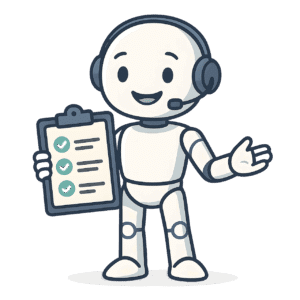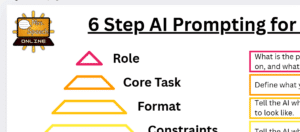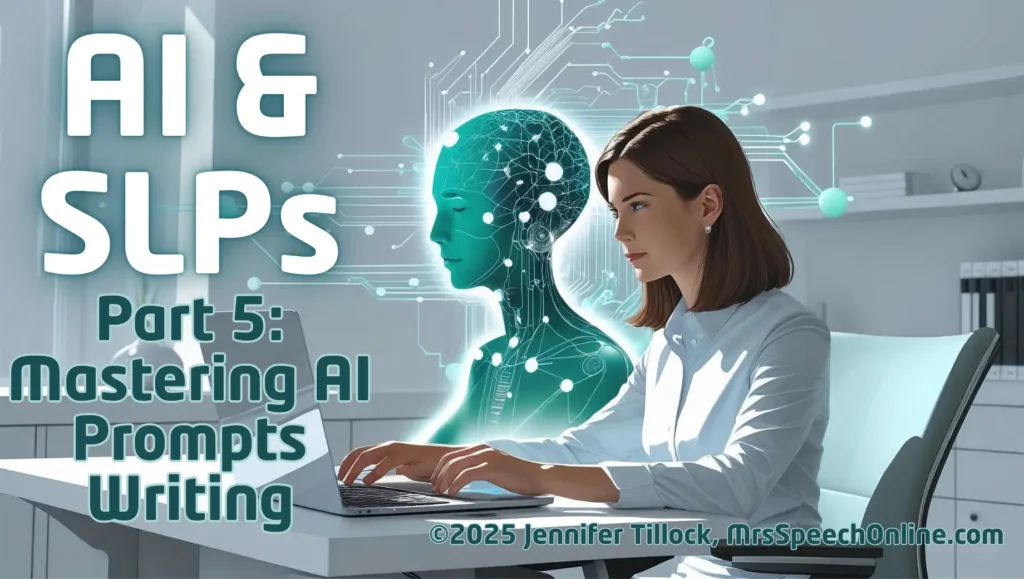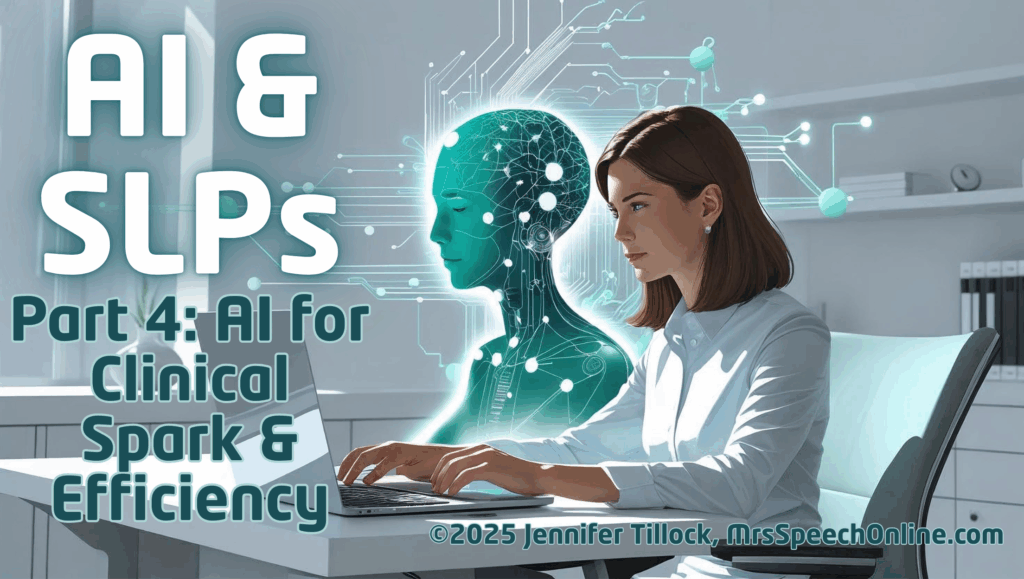How to become an AI whisperer
In Post 4, we saw how AI can be your clinical sidekick—sparking lesson ideas, streamlining documentation, and tackling admin tasks. SLP AI prompt writing is essential for maximizing these benefits. But here’s the truth: AI is only as good as the conversation you start. The magic isn’t in its existence; it’s in how you wield it.
Think of AI as an incredibly intelligent, but frustratingly literal, intern. It operates on your instructions. This is where AI prompt engineering for SLPs comes in—the art and science of communicating effectively with large language models (LLMs). The better your prompt, the more tailored, useful, and relevant the AI’s output will be.

🛑 STOP! The Golden Rule: PHI and AI (Crucial Disclaimer)
Before we dive into prompt perfection, let’s firmly reiterate the absolute necessity: NEVER, EVER input Protected Health Information (PHI) or any client-specific identifying data (such as names, baselines, unique characteristics, or highly specific details that could lead to identification) into general-purpose AI models like CoPilot, ChatGPT, Bard/Gemini’s public interfaces, or similar tools that do not have a specific Business Associate Agreement (BAA) with your organization covering PHI.
Your company’s specific guidance on compliant AI use (especially for integrated tools like Google Workspace’s Gemini) is paramount. Always, always, always prioritize client privacy and confidentiality.
Ready to unlock AI’s full potential? Let’s refine your prompting skills!
6 Principles for Mastering AI Prompts for Speech Therapy
To get the most out of AI, keep these essential principles in mind:

1. Clarity, Conciseness, & Specificity
Vague input equals generic output. The more targeted your request, the more tailored and useful the AI’s response.
- Vague: “Give me therapy ideas.”
- Specific: “Generate 5 engaging speech therapy activities for 7-year-olds working on initial /s/ blends, suitable for a 30-minute session, using a ‘superhero’ theme. List required materials for each.”
2. Assign a Persona (Role & Context)
Tell the AI who it is (e.g., “Act as an experienced pediatric SLP”) and provide relevant background. This is arguably the most crucial step! By assigning a role, you’re pulling from a specialized language subset, which drastically improves the quality and relevance of the output. This is key to effective SLP AI promts.
- Generic: “Write a lesson plan.”
- Contextualized: “Act as an experienced pediatric SLP working in a school setting. Create a 45-minute lesson plan for a small group of 2nd graders targeting narrative language skills, focusing on sequencing events and character emotions. Include a clear objective, suggested materials, step-by-step activities, and differentiation ideas.”
3. Define Output Format & Length
Don’t leave the output format to chance. Tell the AI exactly how you want the information organized (e.g., bullet points, table, short paragraph, email draft).
- Unspecified: “Tell me about dysphagia.”
- Formatted: “Summarize key differences between oral phase and pharyngeal phase dysphagia in a bulleted list, suitable for a 1-page handout for speech therapy graduate students.”
4. Specify Constraints & Exclusions
Tell the AI what not to include, or what limitations to follow. This helps filter out irrelevant or inappropriate information for your client’s needs.
- General: “Give me articulation sentences for /l/.”
- Constrained: “Generate 10 articulation drill sentences for initial /l/ sounds for a 4-year-old, but exclude any words related to food or animals, and ensure sentences are no more than 5 words long.”
5. Iterate & Refine (It’s a Conversation)
Prompting is rarely a one-shot deal. Think of it as a Socratic dialogue—start with a broader request, then refine the AI’s initial response with follow-up instructions until you hit perfection. This process of refining AI prompts for SLP output is essential.
- Iteration Example:
- You: “Give me goals for preschoolers.”
- AI: (Provides very general goals)
- You: “Okay, now make those goals SMART goals for receptive language, focusing on following 2-step directions.”
- AI: (Provides more specific, measurable goals)
✨ Pro-Tip: Meta-Prompting (Make AI Write Your SLP Prompts)
If you are struggling to craft a detailed prompt, turn the tables and ask the AI to help you! This is a fast track to using all the principles above without having to think of every detail yourself.
- Prompt to Refine Your Prompt (Ask for Clarification): Use this when you have a good idea, but aren’t sure what specific details the AI needs, or are unsure if you’ve thought of everything.
- “You are an expert prompt engineer for speech-language pathology. I want to create a 30-minute therapy plan for a 5th grader working on figurative language. Based on this goal, ask me 5 questions to clarify what you need to write the perfect, detailed prompt.”
- Prompt to Generate a Prompt: Use this to ensure your request includes all the necessary components (role, format, constraints).
- “Act as an AI prompt expert. Write a detailed, effective prompt that will generate a handout for parents explaining the difference between an articulation disorder and a phonological disorder. The final prompt must include a specific role, a format, and a suggested reading level.”
6. Consider Tone & Audience
If you’re drafting communication for others, specify the desired tone and intended audience.
- Prompt Example: “Draft a short email to a general education teacher explaining the process of a speech-language screening, using a friendly and informative tone, and inviting them to share any initial concerns.”
Applied Prompt Engineering: AI Strategies for Common SLP Tasks

Let’s apply these principles to the types of tasks that eat up your time, including those that help you build materials! These strategies lead to time-saving AI prompts for SLPs.
Therapy Ideas & Lesson Plans:
- Include: Client age/grade, specific speech/language goal, preferred theme, session length, group size, required materials you have on hand.
- Example: “Act as an experienced SLP. Create a 30-minute narrative therapy session for a group of three 3rd graders working on story grammar (characters, setting, problem, solution). Use a ‘detective’ theme. Include warm-up, main activity, and cool-down. Suggest print-and-go materials and a simple data collection sheet format.”
Goal Wording:
- Specify: Skill area, target population, desired components (e.g., SMART goals, specific measurable elements), context.
- Example: “Generate 3 measurable, long-term speech therapy goals for an elementary student working on pragmatic language skills, focusing on initiating conversations and turn-taking, suitable for an IEP. Then, critique each goal for measurability and compliance.”
Content Adaptation & Materials Creation:
- Key Components: Original content (paste or summarize), target audience, desired reading level, specific language features to focus on.
- Example (Great for TPT!): “Generate a simple 4-page articulation resource for initial /k/, suitable for a third-grade reading level. Format the content as three short reading passages followed by comprehension questions.”
Task Analysis / Prompt Hierarchies:
- Clearly define: The skill to be broken down, the target age/developmental level, the desired number of steps, and the type of prompting.
- Example: “Provide a detailed task analysis for teaching a 5-year-old to correctly produce 3-4 word sentences using correct subject-verb agreement. Include 5-7 steps and suggest different levels of verbal and gestural prompts for each step.”
Administrative Tasks:
- Be precise about: The type of document, the data you’re working with, the desired function, and the output format.
- Example: “I need an Excel formula. I have a list of dates in Column A and attendance marked ‘P’ or ‘A’ in Column B. Give me a formula to count the total number of ‘P’s for the month of March in Column C.”
⚠️ The Guardrails: Where AI Falls Short for SLPs

While AI is a powerful assistant, it’s crucial to understand where its current capabilities fall short. Remember that even with the most effective SLP AI prompts, your clinical judgment is irreplaceable.
- Phonetics and Articulation Nuance: AI operates on text strings, not the underlying speech sounds, articulatory placements, or distinctive features. It can’t “hear” a velar fronting error. This means word lists for specific phonetic contexts (e.g., specific minimal pairs, /r/ contexts) often miss the mark. Always check its work!
- Age/Grade Level Nuance for Language/Vocabulary: While AI can attempt to “simplify” language, its understanding of developmental language milestones, typical vocabulary acquisition, and the subtle nuances of age-appropriate content, syntax and semantics can be limited. Always review carefully for true developmental appropriateness.
- Clinical Judgment Remains Yours: AI lacks clinical reasoning, empathy, and the ability to interpret non-verbal cues or individual client needs. Its output is based on patterns in the data it was trained on, not genuine understanding of a client. Your license, and your client’s well-being, is your responsibility.
The Empowered SLP: An AI Prompting Pro

Mastering prompt engineering is the final step in turning AI from a simple chatbot into your powerful, personalized SLP assistant. This skill won’t replace your expertise, but it will save you time, spark creativity, and allow you to dedicate more of your precious energy to what matters most: the art and science of speech-language pathology. Start experimenting with SLP AI prompt engineering today!
Want a quick reference to help you on your AI prompting journey? This visual provides a 6-step, hierarchical template that teaches SLPs how to define the role, constraints, and format needed to get accurate, clinically relevant output from AI. Only available to Subscribers!
In Post 6, we’ll explore specific AI tools and platforms that SLPs can safely and effectively integrate into their workflow (always with the BAA and privacy rules in mind!).
Next in the Series
- Part 1: AI & Clinical Data Privacy
- This foundational post explores AI training data, client privacy, and HIPAA compliance for SLPs, including the non-negotiable role of BAAs.
- Part 2: Separating AI Truth vs Myth
- We debunk common AI myths in SLP practice. Get a realistic understanding of AI’s true role and capabilities.
- Part 3: How AI Tools Work
- Get a clear, jargon-free explanation of how large language models function. Understand their capabilities and limitations.
- Part 4: AI for Clinical Spark & Efficiency
- Discover ethical ways to use AI. Brainstorm, overcome planning hurdles, and refine non-clinical communications.
- Part 5: Mastering AI Prompts (this post!)
- Learn prompt engineering. Communicate effectively with AI models to get tailored, useful results for SLP needs.
- Part 6: Compliant AI Platforms & Tools
- This post guides you through AI tools. Learn key factors for ethically and compliantly selecting platforms for your SLP practice.
- Part 7: Ethical & Responsible AI Use
- This crucial post delves into broader ethical responsibilities for SLPs using AI. It covers principles beyond data privacy.
- Part 8: The Future of AI
- This concluding post explores emerging AI trends and future possibilities in Speech-Language Pathology. Prepare to adapt, innovate, and lead responsible AI integration.

